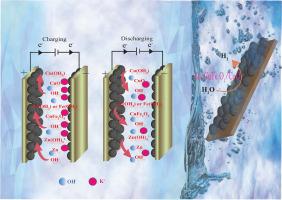电沉积叠层CFZN金属氧化物纳米片作为HER和超级电容器的高性能双功能电催化剂
IF 6.3
3区 工程技术
Q1 ENGINEERING, CHEMICAL
Journal of the Taiwan Institute of Chemical Engineers
Pub Date : 2025-07-27
DOI:10.1016/j.jtice.2025.106299
引用次数: 0
摘要
电催化水分解和超级电容器技术对于可持续能源储存和转换至关重要,为应对全球变暖提供了化石燃料的有效替代品。为了推进生态友好型电化学器件的发展,开发高效耐用的电催化剂是至关重要的,重点是简单可控的制造方法。方法采用简单的电沉积和捕集策略,在3D-Ni (CFZN)衬底上合成了CuO/CuFe₂O₄/Zn堆叠催化剂。这些电极旨在提高超级电容器(SCs)的活性和长期稳定性以及析氢反应(HER)。CFZN纳米片电极在两电极系统中获得了惊人的258 F g⁻¹(0.5 a g⁻¹)的电容。用这些纳米片制备的SC的能量密度为14.52 Wh kg⁻¹,电容保持率为87.11%。CFZN电催化剂表现出令人印象深刻的性能,在碱性环境中,HER的过电位仅为40 mV, Tafel斜率为53 mV dec⁻¹。此外,密度泛函理论(DFT)计算通过态密度(DOS)分析提供了对电子结构的见解,并评估了中间氢吸附的吉布斯自由能。这一理论分析强化了该材料在高性能电化学应用方面的潜力。本文章由计算机程序翻译,如有差异,请以英文原文为准。

Electrodeposition of stacked CFZN metallic oxide nanosheets as high-performance bifunctional electrocatalyst for HER and supercapacitor
Background
Electrocatalytic water splitting and supercapacitor technologies are vital for sustainable energy storage and conversion, providing effective alternatives to fossil fuels in addressing global warming. To advance eco-friendly electrochemical devices, it is essential to develop highly efficient and durable electrocatalysts, focusing on simple and controllable fabrication methods.
Methods
In this study, we synthesized stacked CuO/CuFe₂O₄/Zn catalysts on a 3D-Ni substrate, termed CFZN, using a simple electrodeposition and trapping strategy. These electrodes aim to improve the activity and long-term stability of supercapacitors (SCs) and the hydrogen evolution reaction (HER). The CFZN nanosheets electrode achieved a remarkable capacitance of 258 F g⁻¹ at 0.5 A g⁻¹ in a two-electrode system.
Significant Findings
The SC fabricated with these nanosheets presented an energy density of 14.52 Wh kg⁻¹ and a capacitance retention of 87.11 %. The CFZN electrocatalyst exhibited impressive performance with overpotentials of just 40 mV and Tafel slope values of 53 mV dec⁻¹ for HER in an alkaline environment. Additionally, density functional theory (DFT) calculations provided insights into the electronic structure through density of states (DOS) analysis and evaluated the Gibbs free energy of intermediate hydrogen adsorption. This theoretical analysis reinforces the material's potential for high-performance electrochemical applications.
求助全文
通过发布文献求助,成功后即可免费获取论文全文。
去求助
来源期刊
CiteScore
9.10
自引率
14.00%
发文量
362
审稿时长
35 days
期刊介绍:
Journal of the Taiwan Institute of Chemical Engineers (formerly known as Journal of the Chinese Institute of Chemical Engineers) publishes original works, from fundamental principles to practical applications, in the broad field of chemical engineering with special focus on three aspects: Chemical and Biomolecular Science and Technology, Energy and Environmental Science and Technology, and Materials Science and Technology. Authors should choose for their manuscript an appropriate aspect section and a few related classifications when submitting to the journal online.

 求助内容:
求助内容: 应助结果提醒方式:
应助结果提醒方式:


